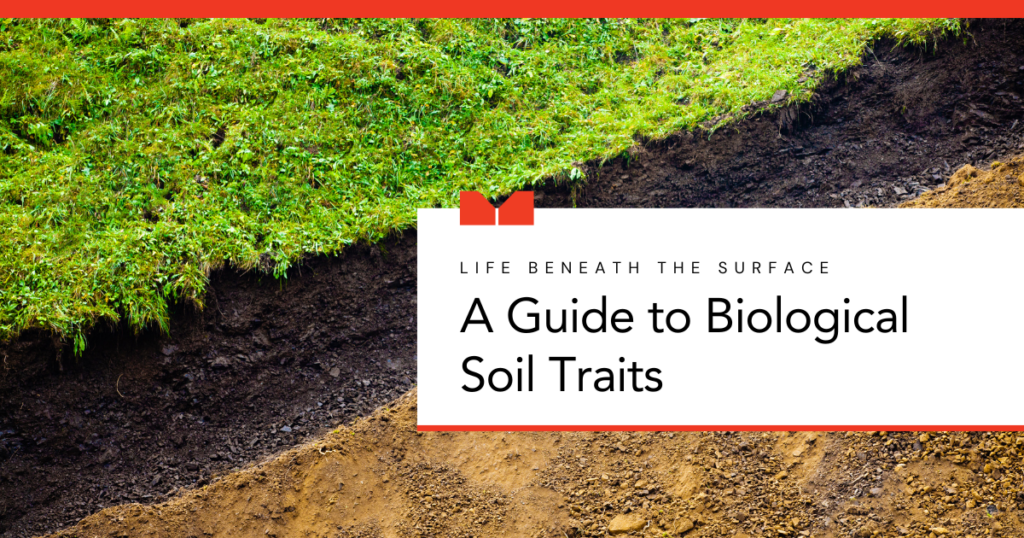
A Guide to Biological Soil Characteristics: Life Beneath the Surface
While this blog series has explored the physical and chemical traits of healthy soil, there is another crucial aspect: the biological characteristics of soil.
“A gram of soil — about a quarter of a teaspoon — can easily contain a billion bacterial cells and several miles of fungal filaments,” says Kate Scow, a professor of soil science and soil microbial ecology at UC Davis.
All of these tiny life forms (think tiny microbes, earthworms, and insects) that live in soil are major players in the health, longevity, and potential of soil. Healthy soil is teeming with life, which contributes to nutrient cycling, disease suppression, and overall soil structure.
In this post, we’ll dig into the biological characteristics of soil – specifically a diverse microorganism population and high levels of organic matter – and explain why they matter and how they contribute to a thriving farm.
Diverse microorganism population: the soil’s workforce
Soil microbes, including bacteria, fungi, and protozoa, are essential to soil health. Microbes perform many critical functions during their lifespans underground, like breaking down organic matter, cycling nutrients, and helping plants access those nutrients. A diverse and abundant microbial community ensures that these processes happen smoothly, all the while supporting plant growth and maintaining soil fertility.
Healthy soil is like a bustling city, full of different microbes performing various roles. Bacteria decompose organic matter and release nutrients, fungi form symbiotic relationships with plant roots, and other organisms help control pests. This diversity creates a balanced, resilient soil ecosystem that can better withstand challenges like disease and drought.
High levels of organic matter: the soil’s food supply
Soil Organic Matter (SOM) is the lifeblood of healthy soil. It consists of plant residues, animal manures, and other decomposed materials that provide food for soil-based organisms. As organic matter breaks down, it releases nutrients that plants need to grow. SOM improves soil structure, increases water retention, and enhances the soil’s ability to hold onto nutrients.
In well-managed soils, organic matter breaks down gradually, continuously fueling the microbial community and enriching the soil. The result is a fertile, well-structured soil that supports robust plant growth.
Microalgae’s impact on biological characteristics of soil
Introducing live, native microalgae enhances the biological health of your soil by:
- Boosting microbial activity: Live microalgae serve as a food source for soil microbes at the very base level of the soil food chain. This helps to increase populations and microbe diversity. The result? More efficient nutrient cycling – which gets the nutrients to plants more efficiently in bioavailable forms – better soil fertility and improved biological traits of soil.
- Increasing organic matter: As live microalgae grow, reproduce in the soil, and eventually die, they add to the organic content of the soil (SOM). This both feeds microbes and improves soil structure and water retention.
- Creating a thriving ecosystem: Live, native microalgae can contribute to enhanced soil porosity, allowing more oxygen and water to reach soil microbes. This creates an ideal environment for these organisms to flourish, further boosting soil health.
By using MyLand’s Soil as a Service, which empowers growers to quickly and efficiently contribute live, native microalgae to their soil, growers can support their biological characteristics of soil and a vibrant, active microbial community which is key to overall soil health.
Wrapping up the soil health series
Over this series, we’ve explored the three key traits, or characteristics, of healthy soil: physical, chemical, and biological. Each of these traits plays a crucial role in creating an environment in the soil where plants can thrive. From the structure and depth of your soil to its nutrient content and microbial life, every aspect works together to support healthy plants. By understanding and nurturing the biological, physical and chemical characteristics of your soil, you’re setting yourself up for success in your growing endeavors. Want to take your soil to the next level? See how MyLand can help.